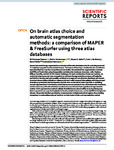On brain atlas choice and automatic segmentation methods: a comparison of MAPER & FreeSurfer using three atlas databases
| dc.contributor.author | Yaakub, Siti Nurbaya | |
| dc.contributor.author | Heckemann, RA | |
| dc.contributor.author | Keller, SS | |
| dc.contributor.author | McGinnity, CJ | |
| dc.contributor.author | Weber, B | |
| dc.contributor.author | Hammers, A | |
| dc.date.accessioned | 2023-02-20T12:51:36Z | |
| dc.date.issued | 2020-02 | |
| dc.identifier.issn | 2045-2322 | |
| dc.identifier.issn | 2045-2322 | |
| dc.identifier.other | 2837 | |
| dc.identifier.uri | http://hdl.handle.net/10026.1/20466 | |
| dc.description.abstract |
<jats:title>Abstract</jats:title><jats:p>Several automatic image segmentation methods and few atlas databases exist for analysing structural T1-weighted magnetic resonance brain images. The impact of choosing a combination has not hitherto been described but may bias comparisons across studies. We evaluated two segmentation methods (MAPER and FreeSurfer), using three publicly available atlas databases (Hammers_mith, Desikan-Killiany-Tourville, and MICCAI 2012 Grand Challenge). For each combination of atlas and method, we conducted a leave-one-out cross-comparison to estimate the segmentation accuracy of FreeSurfer and MAPER. We also used each possible combination to segment two datasets of patients with known structural abnormalities (Alzheimer’s disease (AD) and mesial temporal lobe epilepsy with hippocampal sclerosis (HS)) and their matched healthy controls. MAPER was better than FreeSurfer at modelling manual segmentations in the healthy control leave-one-out analyses in two of the three atlas databases, and the Hammers_mith atlas database transferred to new datasets best regardless of segmentation method. Both segmentation methods reliably identified known abnormalities in each patient group. Better separation was seen for FreeSurfer in the AD and left-HS datasets, and for MAPER in the right-HS dataset. We provide detailed quantitative comparisons for multiple anatomical regions, thus enabling researchers to make evidence-based decisions on their choice of atlas and segmentation method.</jats:p> | |
| dc.format.extent | 2837- | |
| dc.format.medium | Electronic | |
| dc.language | en | |
| dc.language.iso | eng | |
| dc.publisher | Springer Science and Business Media LLC | |
| dc.subject | Aged | |
| dc.subject | Aged, 80 and over | |
| dc.subject | Alzheimer Disease | |
| dc.subject | Brain | |
| dc.subject | Databases, Factual | |
| dc.subject | Epilepsy, Temporal Lobe | |
| dc.subject | Female | |
| dc.subject | Hippocampus | |
| dc.subject | Humans | |
| dc.subject | Image Interpretation, Computer-Assisted | |
| dc.subject | Image Processing, Computer-Assisted | |
| dc.subject | Magnetic Resonance Imaging | |
| dc.subject | Male | |
| dc.subject | Middle Aged | |
| dc.title | On brain atlas choice and automatic segmentation methods: a comparison of MAPER & FreeSurfer using three atlas databases | |
| dc.type | journal-article | |
| dc.type | Journal Article | |
| dc.type | Research Support, Non-U.S. Gov't | |
| dc.type | Research Support, U.S. Gov't, Non-P.H.S. | |
| plymouth.author-url | https://www.webofscience.com/api/gateway?GWVersion=2&SrcApp=PARTNER_APP&SrcAuth=LinksAMR&KeyUT=WOS:000560400000005&DestLinkType=FullRecord&DestApp=ALL_WOS&UsrCustomerID=11bb513d99f797142bcfeffcc58ea008 | |
| plymouth.issue | 1 | |
| plymouth.volume | 10 | |
| plymouth.publication-status | Published online | |
| plymouth.journal | Scientific Reports | |
| dc.identifier.doi | 10.1038/s41598-020-57951-6 | |
| plymouth.organisational-group | /Plymouth | |
| plymouth.organisational-group | /Plymouth/Faculty of Health | |
| plymouth.organisational-group | /Plymouth/Faculty of Health/School of Psychology | |
| plymouth.organisational-group | /Plymouth/Users by role | |
| plymouth.organisational-group | /Plymouth/Users by role/Academics | |
| dc.publisher.place | England | |
| dcterms.dateAccepted | 2019-11-27 | |
| dc.rights.embargodate | 2023-2-21 | |
| dc.identifier.eissn | 2045-2322 | |
| dc.rights.embargoperiod | Not known | |
| rioxxterms.versionofrecord | 10.1038/s41598-020-57951-6 | |
| rioxxterms.licenseref.uri | http://www.rioxx.net/licenses/all-rights-reserved | |
| rioxxterms.licenseref.startdate | 2020-02-18 | |
| rioxxterms.type | Journal Article/Review |


